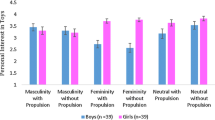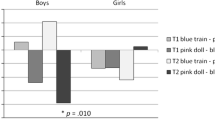Abstract
This study assessed the relative influences of approach and avoidance behaviors toward same-sex and cross-sex toys in the play of children with gender identity disorder and in normal boys, normal girls, and psychiatric controls. Three forced-choice situations with toys and three forced-choice situations with dress-up apparel were presented that paired same-sex and cross-sex stimuli, same-sex and neutral stimuli, and cross-sex and neutral stimuli. In the same-sex/cross-sex situation, the gender-disordered group played a significantly shorter time with the same-sex stimuli and a significantly longer time with the cross-sex stimuli than the normal boys and the psychiatric controls, whereas the play patterns of the normal girls fell in between that of the gender-disordered group and the other two control groups. Within-groups analyses showed that the normal boys and the psychiatric controls preferred the same-sex toys, whereas the gender-disordered group and the normal girls showed no preference. When the neutral toys were the alternative, avoidance of cross-sex toys appeared to be stronger than the attraction to same-sex toys in the normal boys and in the psychiatric controls. The relative influence of approach-avoidance tendencies was more equivocal in the gender-disordered group, though they appeared to have a weaker attraction to same-sex toys and less avoidance of cross-sex toys in comparison with the normal boys and the psychiatric controls. The approach-avoidance patterns of the normal girls fell in between that of the gender-disordered group and the other two control groups.
Similar content being viewed by others
References
Achenbach, T. M., & Edelbrock, C. (1983).Manual for the Child Behavior Checklist and Revised Child Behavior Profile. Burlington, VT: University Associates in Psychiatry.
American Psychiatric Association. (1980).Diagnostic and statistical manual of mental disorders (3rd ed.). Washington, DC: Author.
American Psychiatric Association. (1987).Diagnostic and statistical manual of mental disorders (3rd ed., rev.). Washington, DC: Author.
Brown, D. G. (1956). Sex-role preference in young children.Psychological Monographs, 70 (14, Whole No. 421).
Cole, H. J., Zucker, K. J., & Bradley, S. J. (1982). Patterns of gender role behavior in children attending traditional and non-traditional day-care centers.Canadian Journal of Psychiatry, 27, 135–139.
Connor, J. M., & Serbin, L. A. (1977). Behaviorally-based masculine and feminine activity preference scales for children: Correlates with other classroom behaviors and cognitive tests.Child Development, 48, 1411–1416.
Dickstein, E. B., & Seymour, M. W. (1977). Effect of the addition of neutral items on IT Scale scores.Developmental Psychology, 13, 79–80.
Doering, R. W. (1981).Parental reinforcement of gender-typed behaviors in boys with a typical gender identity. Unpublished doctoral dissertation, University of Toronto.
Edelbrock, C., & Sugawara, A. I. (1978). Acquisition of sex-typed preferences in preschool-aged children.Developmental Psychology, 14, 614–623.
Fagot, B. I., Leinbach, M. D., & Hagan, R. (1986). Gender labeling and the adoption of sextyped behaviors.Developmental Psychology, 22, 440–443.
Fein, G., Johnson, D., Kosson, N., Stork, L., & Wasserman, L. (1975). Sex stereotypes and preferences in the toy choices of 20-month-old boys and girls.Developmental Psychology, 11, 527–528.
Green, R. (1976). One hundred ten feminine and masculine boys: Behavioral contrasts and demographic similarities.Archives of Sexual Behavior, 5, 425–446.
Green, R., (1987).The “sissy boy syndrome” and the development of homosexuality. New Haven, CT: Yale University Press.
Green, R., Fuller, M., Rutley, B. R., & Hendler, J. (1972). Playroom toy preferences of fifteen masculine and fifteen feminine boys.Behavior Therapy, 3, 425–429.
Hartup, W. W., Moore, S. G., & Sager, G. (1963). Avoidance of inappropriate sex typing by young children.Journal of Consulting Psychology, 27, 467–473.
Hollingshead, A. B. (1975).Four factor index of social status. Unpublished manuscript, Department of Sociology, Yale University.
Kirk, R. E. (1968).Experimental design: Procedures for the behavioral sciences. Belmont, CA: Brooks/Cole.
Kramer, C. Y. (1956). Extension of multiple range tests to group means with unequal numbers of replications.Biometrics, 12, 307–310.
Muller, R., & Goldberg, S. (1980). Why William doesn't want a doll: Preschoolers' expectations of adult behavior toward girls and boys.Merrill-Palmer Quarterly, 26, 259–269.
O'Brien, M., & Huston, A. C. (1985). Development of sex-typed play in toddlers.Developmental Psychology, 21, 866–871.
O'Brien, M., Huston, A. C., & Risley, T. R. (1983). Sex-typed play of toddlers in a day care center.Journal of Applied Developmental Psychology, 4, 1–9.
Rekers, G. A., & Yates, C. E. Sex-typed play in feminoid boys versus normal boys and girls.Journal of Abnormal Child Psychology, 4, 1–8.
Ross, D. M., & Ross, S. A. (1972). Resistance by preschool boys to sex-inappropriate behavior.Journal of Educational Psychology, 63, 342–346.
Schau, C. G., Kahn, L., Diepold, J. H., & Cherry, F. (1980). The relationships of parental expectations and preschool children's verbal sex typing to their sex-typed toy play behavior.Child Development, 51, 266–270.
Viera, K. G., & Miller, W. H. (1978). Avoidance of sex-atypical toys by five- and ten-year old children.Psychological Reports, 43, 543–546.
Zucker, K. J. (1985). Cross-gender-identified children. In B. W. Steiner (Ed.),Gender dysphoria: Development, research, management (pp. 75–174). New York: Plenum Press.
Zucker, K. J., Bradley, S. J., Corter, C. M., Doering, R. W., & Finegan, J. K. (1980). Crossgender behaviour in very young boys: A normative study. In J. Sampson (ed.),Childhood and sexuality (pp. 599–622). Montreal: Editions Etudes Vivantes.
Zucker, K. J., Doering, R. W., Bradley, S. J., & Finegan, J. K. (1982). Sex-typed play in gender-disturbed children: A comparison to sibling and psychiatric controls.Archives of Sexual Behavior, 11, 309–321.
Zucker, K. J., Finegan, J. K., Doering, R. W., & Bradley, S. J. (1983). Human figure drawings of gender-problem children: A comparison to sibling, psychiatric, and normal controls.Journal of Abnormal Child Psychology, 11, 287–298.
Zucker, K. J., Finegan, J. K., Doering, R. W., & Bradley, S. J. (1984). Two subgroups of gender-problem children.Archives of Sexual Behavior, 13, 27–39.
Author information
Authors and Affiliations
Rights and permissions
About this article
Cite this article
Doering, R.W., Zucker, K.J., Bradley, S.J. et al. Effects of neutral toys on sex-typed play in children with gender identity disorder. J Abnorm Child Psychol 17, 563–574 (1989). https://doi.org/10.1007/BF00916514
Revised:
Issue Date:
DOI: https://doi.org/10.1007/BF00916514




